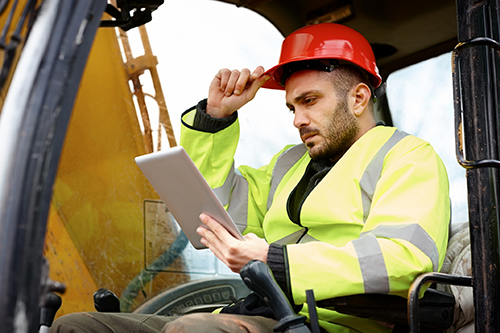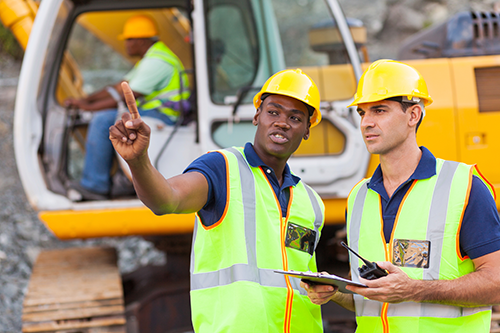One of the biggest opportunities for a construction fleet manager is to gain insights from the data coming off the equipment. Leveraging this information will help make more informed decisions, ultimately improving the bottom line.
Today, there are two big equipment technologies that are impacting the construction industry—and these will be critical for fleet managers, in particular, in the months ahead.
Integrated Grade Control Systems
Grade control systems have evolved extensively during the last few years with a deeper integration into the machine platform and the implementation of systems that help improve accuracy and reduce the time to complete grading tasks.
These integrated systems leverage both grade control and machine automation to deliver solutions that are easier to use and quickly transform good operators into great operators, explains Andrew Kahler, product marketing manager, John Deere WorkSight.
“For example, in 2016 John Deere introduced SmartGrade crawlers to deliver a highly integrated 3D grade control system,” he says. “The automated system with Auto SmartGrade prevents track slip and maximizes material moved to deliver productivity from the first pass to the final pass.”
This system is also a mastless system that mounts the GPS receivers on the cab. This eliminates the need for exposed cables that can be damaged and reduces the likelihood of receiver damage and theft.
“It allows dirt work and especially grading jobs to be done more accurately and more quickly with less work,” he explains. “Jobsites driven by 3D models are becoming the industry norm and integrated grade control systems allow contractors to complete jobs on a broader scale.”
As another example, Trimble offers a complete line of grade control systems—from laser or sonic-based through to 3D. More specifically, it offers an Earthworks Grade Control Platform to help operators do more in less time. It runs on the Trimble touchscreen Android display and was created in collaboration with construction equipment operators around the world.
Operators can personalize the interface to match their workflow and the data can be transferred to or from the office wirelessly and automatically they always have the latest design.
While these are just a few examples, grade control continues to advance for the construction jobsite, enabling operators to achieve grade consistently, with high accuracy and in less time.
 Telematics and Machine Health Monitoring
Telematics and Machine Health Monitoring
The second big trend for the construction industry isn’t necessarily new, but is growing at a rapid pace. Telematics provides insights to help customers visualize machine health and productivity.
Jenny Elfsberg, director emerging technologies, Volvo, suggests that telematics on board machines can enable preventative maintenance and fault identification that will prevent unexpected downtime. It will help complete the given task more easily and will capture the data to prove the desired work has been carried out to specification.
Kahler of John Deere WorkSight adds that these insights will help customers visualize machine health and productivity.
“Telematics and machine health monitoring is all about uptime and productivity tracking,” he says. “These tools help customers keep track of their fleet and allows for better utilization of the assets they have.”
This is in line with growth predictions from the analysts. Transparency Market Research indicates that the global telematics in heavy equipment market is expected to rise 11.5 percent between 2017 and 2025, due to increasing demand for various field positioning capabilities offered by the telematics.
The report shows that operators are realizing more benefits of telematics such as theft reduction, reduction in fuel consumption, and improved efficiency of heavy equipment. It also provides safety to fleet operators by enabling them to observe noise limit requirements and real-time site access.
 What’s Next for Technology?
What’s Next for Technology?
As these two technologies—grade control and telematics—continues to gain momentum in the construction industry, companies will need to develop strategies and best practices for how it is leveraged on the job site.
Elfsberg of Volvo suggests specifying these systems on new machines, and while training on the new systems is important, ease-of-use means that less experienced operators can complete the work, thereby helping to ease the skills shortage in the industry.
Kahler adds, “To put good strategies in place, a construction company should consider the greatest pain points it is experiencing. If a pain point is finding skilled operators or meeting bid specifications, then integrated grade control systems should be considered. If downtime or maintenance scheduling is the issue, telematics and machine health monitoring might be worth exploring.”
Further, construction companies will need to identify how to implement and train workers to be safe while implementing the new technologies—especially on projects like road work where there is a greater risk for getting injured.
To help, Jessica Scheyder, director of training, American Traffic Safety Services Association (ATSSA), suggests that it comes down to high-quality course materials, knowledgeable instructors, and a solid grasp of the industry—particularly with regard to safety regulations and equipment.
“Construction companies can ensure their employees working on the roadways are up-to-date with certifications, properly trained to carry out tasks on site, and stay knowledgeable of the latest recommendations for products and safety practices,” she says.
Such practices can be found in guides such as the Manual for Assessing Safety Hardware. Finally, standardization becomes critical for ensuring safety on jobsites, and there are many work practices that are recognized by industry entities and federal agencies.
These technologies—telematics and grade control—offer the prospect of greater returns and a competitive advantage. The end result is work is completed faster, which means that machines can be moved onto other work more quickly. For construction operators, these are two of the top technologies that are impacting the construction industry today—and will continue to change how work is done at the jobsite in the future.












